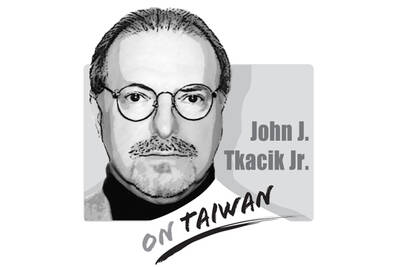It's a familiar pattern. First there is some kind of disaster -- yesterday it was the financially hard-hitting (damage estimated at US$20 million) but otherwise innocuous Eastern Science Park fire; last October it was the tragic crash of SQ006 at CKS Airport and the flooding in Keelung after Typhoon Xangsane; last July saw the Pachang Creek (
First legislators with something to prove -- usually only that they are flatulent egotists, as TV viewers saw Taipei County Legislator Lo Ming-tsai (
Then out come the "big shots" -- we use the term ironically -- who point out that it is all the government's fault and heads must roll. Yesterday's poltroon of the day was KMT spokesman Wang Chih-kang (
In the next few days we can expect ritual denunciations from all the opposition parties and demands that some highly placed official, probably Premier Chang Chun-hsiung (
Oh, and the government will have to set up a task force. We understand one will be established this morning for "recovery" though surely that is the concern of the companies whose property has been damaged and their insurance companies.
The din of the all-style, no-content political show may drown out the real questions to be asked from the Hsichih fire, which would be a pity. One of these will be why there was no available fire truck with an extendable ladder which could reach the upper floors of the burning building. Taipei County apparently doesn't have one. Neither does anybody else. But this may be a red herring. As an architect told this newspaper's reporter, tall buildings rely on their own containment and extinguishing systems to fight fires; ladder trucks can do comparatively little. That the fire was so damaging was, apparently, a result of the failure of the building's electrical system on which its sprinkler operation depended.
So here's the really interesting question: the building was constructed only six years ago to conform to safety standards which remain largely unchanged. So how could such a disastrous system malfunction happen? Should it, could it have been foreseen? Was it bad luck -- there really is such a thing -- or bad planning? There is real need to know; let us hope that this is not forgotten amid the surrounding political cacophony.

On May 7, 1971, Henry Kissinger planned his first, ultra-secret mission to China and pondered whether it would be better to meet his Chinese interlocutors “in Pakistan where the Pakistanis would tape the meeting — or in China where the Chinese would do the taping.” After a flicker of thought, he decided to have the Chinese do all the tape recording, translating and transcribing. Fortuitously, historians have several thousand pages of verbatim texts of Dr. Kissinger’s negotiations with his Chinese counterparts. Paradoxically, behind the scenes, Chinese stenographers prepared verbatim English language typescripts faster than they could translate and type them
More than 30 years ago when I immigrated to the US, applied for citizenship and took the 100-question civics test, the one part of the naturalization process that left the deepest impression on me was one question on the N-400 form, which asked: “Have you ever been a member of, involved in or in any way associated with any communist or totalitarian party anywhere in the world?” Answering “yes” could lead to the rejection of your application. Some people might try their luck and lie, but if exposed, the consequences could be much worse — a person could be fined,
Xiaomi Corp founder Lei Jun (雷軍) on May 22 made a high-profile announcement, giving online viewers a sneak peek at the company’s first 3-nanometer mobile processor — the Xring O1 chip — and saying it is a breakthrough in China’s chip design history. Although Xiaomi might be capable of designing chips, it lacks the ability to manufacture them. No matter how beautifully planned the blueprints are, if they cannot be mass-produced, they are nothing more than drawings on paper. The truth is that China’s chipmaking efforts are still heavily reliant on the free world — particularly on Taiwan Semiconductor Manufacturing
Last week, Nvidia chief executive officer Jensen Huang (黃仁勳) unveiled the location of Nvidia’s new Taipei headquarters and announced plans to build the world’s first large-scale artificial intelligence (AI) supercomputer in Taiwan. In Taipei, Huang’s announcement was welcomed as a milestone for Taiwan’s tech industry. However, beneath the excitement lies a significant question: Can Taiwan’s electricity infrastructure, especially its renewable energy supply, keep up with growing demand from AI chipmaking? Despite its leadership in digital hardware, Taiwan lags behind in renewable energy adoption. Moreover, the electricity grid is already experiencing supply shortages. As Taiwan’s role in AI manufacturing expands, it is critical that